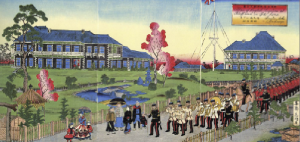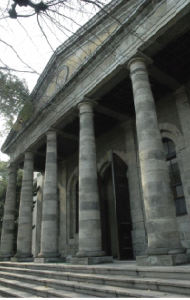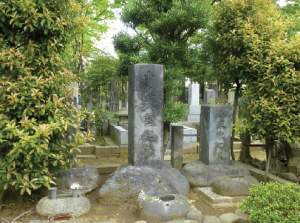The Oriental Irish
Published in Features, Issue 1 (January/February 2014), Volume 22
An 1869 painting by Hee Zhai Xiang of Irishman John Fenton leading the band of the British Army’s 10th Foot Regiment. Despite the fact that they look Japanese, the caption (in English and Japanese) identifies them as the ‘English legation . . . in Yokohama’. (Maspro Denkoh Museum of Art)
Japan has always been seen as an inscrutable nation. More so than the Chinese, Vietnamese or Korean people, the Japanese have maintained a reputation for being insular, self-contained and private. This inscrutability is visible in their language, culture and mannerisms, but it was never as clear as during the period of Sakoku (‘chained country’).
Sakoku was an isolationist policy in Japan whereby no person was permitted to enter or leave the country, under pain of death. The policy was brought into effect by the Tokugawa Shogunate in the 1630s and lasted until 1853. The Tokugawa Shogunate was a hereditary system of military lords who held power in Japan from c. 1600 to 1868. After the Shimabara rebellion in 1637, which was blamed on local Christians, the Sakoku policy was enacted and all foreigners were expelled from Japan, except for those residing in Dejima, a small artificial island in Nagasaki city. This island served as the only point of contact and trade between Japan and the outside world for over 200 years.
When Commodore Matthew Perry arrived in Japan with American and British naval squadrons, he came with an ultimatum: open Japan to trade or face military action. This led to several treaties and the first large-scale interaction between Japan and the rest of the world. Japan went through a massive industrialisation in a short period, and Irish people were amongst those who came to make their mark on the newly rediscovered nation. The first recorded Irishman in Japan was Robert Janson from Waterford. In 1704 he was seized off the coast of Kyushu and brought to Dejima Island. This may not have been the most auspicious of starts, but further interactions with the Irish proved more beneficial for both sides.
John Fenton

Above: The façade of Irish architect Thomas Waters’s Imperial Japanese Mint in Osaka bears a striking resemblance to the east portico of Dublin’s Bank of Ireland.
John William Fenton was born in Kinsale, Co. Cork, in 1828. He joined the British Army and was appointed as the bandmaster of the 10th Foot Regiment. In 1868, in order to protect the small community of non-nationals living in Yokohama, Fenton’s unit was moved to Japan. This was due to the recent military defeat of the Tokugawa Shogunate by forces loyal to the emperor, and the possibility of lingering danger to or resentment of foreigners.
Fenton can claim to be the father of band music in Japan. After Japanese naval cadets overheard Fenton’s band performing, they asked him to instruct them in band music, leading to the formation of the first band in the Japanese Navy. Japan’s leadership believed in a modern, unified country, but they lacked a national anthem, so Fenton was commissioned to compose the music for one, while a Japanese artillery captain, Iwao Óyama, would choose the words. Óyama chose a tenth-century poem for which Fenton composed a melody. The new anthem, Kimi ga Yo, was performed for the emperor shortly afterwards. In 1870 Fenton’s arrangement, considered to be too similar to a military march, was modified by Hayashi Hiromori, a musician at the imperial court, to a more solemn tune. In 1880 the current version of the anthem was composed by Franz Eckert, using western-style harmonies and instruments. Eckert’s tune incorporated elements from Fenton’s original melody, while still retaining Hiromori’s solemnity. To this day, Fenton’s original score is still performed annually at the Myókóji Shrine, near to where Fenton’s unit was stationed in Yokohama city.
Thomas Waters

Above: ‘A man of faith, an undefiled flower blooming like eight clouds, who dwells in the mansion of enlightenment’—Lafcadio Hearn’s grave in Zoshigaya Cemetery, Tokyo
Thomas Waters was born in Birr, Co. Offaly, in 1842. He came from a wealthy family and became an architect. When still in his twenties, he won the commission to design the royal mint in Hong Kong. While there, Waters met Thomas Blake Glover, a Scottish merchant and industrialist who was living in Nagasaki. On Glover’s invitation Waters came to Japan in 1864, and in 1868 was hired by the new Meiji government to build the Imperial Japanese Mint in Osaka. The façade of the mint bears a striking resemblance to the east portico of Dublin’s Bank of Ireland, originally the entrance to the Irish House of Lords, part of an extension designed by James Gandon in the 1790s. Waters was likely inspired by the structure and others like it. Upon completion of that commission, he was employed as a foreign adviser by the government and designed a branch of the Imperial Japanese Mint in Ginza, Tokyo. He also designed several bridges and the headquarters of the Imperial Japanese Army.
Ginza was a historically wealthy, up-market part of Tokyo (gin means silver in Japanese). After a fire devastated the area in 1872, locals were eager to rebuild it in the most modern way possible. To that end, Waters was commissioned to rebuild whole sections of Ginza. He drew inspiration from Dublin city and redesigned the area around a broad central thoroughfare, with numerous two- and three-storey Georgian-style buildings. Ginza soon became a symbol of wealth, westernisation and modernity in Japan and was nicknamed Rengagai or ‘Brick-town’. But as more Western architects flocked to Japan, in 1877 Waters’s contract was not renewed. Soon after, he left to work in Shanghai, and finally in Colorado in the United States.
Other Irishmen contributed to Japan’s rapid development in the late nineteenth century, such as Charles Dickenson West, hired by the Japanese government as an adviser to keep them abreast of the latest technological advances. There were also Japanese people who came to Ireland to learn. The Iwakura mission is probably the most famous. The mission, which consisted of a government adviser and over 100 students and experts, visited Europe and America in order to learn the latest modern technological and educational practices to take back to the rapidly developing Japan. The deputy leader of the mission, Takayoshi Kido, along with several other members, visited Dublin in 1872. While there, they observed many different industrial practices, including the manufacture of stout at the Guinness brewery.
Koizumi Yakumo/Lafcadio Hearn

bust in the Lafcadio Hearn Memorial Park in Okubo, Shinjuku, Tokyo.
Arguably the most famous Irish person in Japanese history was the prominent thinker and writer Koizumi Yakumo. Born Lafcadio Hearn in 1850 in Greece, to an Irish father and a Greek mother, he was raised (from age two) by an aunt in Rathmines, Dublin, and later emigrated to America. He lived and worked in New Orleans as a writer and journalist and in 1890 he moved again, to Japan, where he spent the remaining fourteen years of his life.
His life in Japan was prolific. He married a Japanese woman, Koizumi Setsu, had four children with her, took Japanese citizenship under the name Koizumi Yakumo, served as a schoolmaster in the town of Matsue and later became a professor of English literature in the Imperial University of Tokyo. Hearn wrote twelve books on Japan and Japanese culture and consequently is credited with providing some of the first information about Japanese society to the Western public.
Hearn was staunchly opposed to modernisation and the loss of old traditions. He wrote several books on Japanese myths and legends, attempting to preserve the history of Japan in any way he could. His last book, Japan, an attempt at interpretation (published posthumously), was intended to be a historical analysis of the rapid transformation of Japan from a feudal, agricultural society to a modern industrial one. Today, with Japanese traditions being preserved or revived, Hearn’s work remains popular. Reviewers of his most famous book, Glimpses of unfamiliar Japan, have described it as a series of ‘love letters to the Land of the Rising Sun’. It contains many myths, legends and stories about Japanese society, culture and history.
Hearn’s residences in Japan have been preserved as historical sites, and his works are on display in the Yakumo Museum in Matsue. There are also two statues of him in Ueno Park, Tokyo. His gravestone bears the memorial poem: ‘A man of faith, an undefiled flower blooming like eight clouds, who dwells in the mansion of enlightenment’. With Hearn’s prolific work, it is unsurprising that Japanese people have heard of him. In addition to his written work, Japanese director Masaki Kobayashi adapted four of Hearn’s tales into an anthology of horror films called Kwaidan (‘Ghost stories’) in 1965. What is surprising, however, is that very few Japanese people know him by his real name. Many have heard of Koizumi Yakumo but not of Lafcadio Hearn. To say that Hearn mixed with Japanese society is an understatement; his lyrical grasp of language and storytelling was such that he truly became a part of Japanese society. HI
Matthew Jones studied history and Irish at UCD and now lives and works in Nagasaki, Japan.
Further reading
L.M. Cullen, A history of Japan, 1582–1941: internal and external worlds (Cambridge, 2003).
L. Hearn, Glimpses of an unfamiliar Japan (Tokyo, 1894).
J. Huffman, Modern Japan: an encyclopaedia of history, culture and nationalism (Oxford, 1997).
Koizumi Setsu, Reminiscences of Lafcadio Hearn (Boston, 1918).


















